It’s an annual tradition in American agriculture. Comprising of shiny paint, cheap motel coffee, that oddly springy conference center carpet, matching company polo shirts and business cards. Don’t forget the bags of company swag and scribbled-down notes about the latest new ag products and services. But not this year.
Change underfoot from the COVID-19 pandemic and limitations on large events call on ag companies to take steps to stay ahead of the curve to sustain farm show customer connections. While there’s no silver bullet for providing the ideal virtual farm show experience, there are a few things companies can keep in mind in working toward that goal.
Virtual trade show strategies
The most important thing to keep in mind is the heart of every farm show. The farmer or rancher who has the agribusiness world within arm’s reach. Shows — in-person or virtual — facilitate promotion of and purchase decisions on new machinery, equipment, technology and other necessary tools of the trade, all in a community environment that is often just as important as the potential purchases borne out of show attendance.
It’s sometimes easy to overthink what needs to happen to sustain showgoer interest and farm show attendance ROI. This is especially true with virtual trade shows being a relatively new part of the business. Start the process by first answering these basic questions:
- Do I need to hit every virtual show? What farm shows are most important to your company? Many years — especially when the ag markets are bullish and farmers feel more confident to spend on things like new machinery — you’ll see a lot of the same companies at most all of the major shows. But maybe it’s better to invest more in your presence at a smaller number of virtual shows instead of being there every time attendees turn around. That can enable you to possibly free up budget, for example, to produce follow-up materials that extend the resonance of your messaging to potential customers. No matter what you decide, always keep ROI top-of-mind.
- What do I want my customers to think and do? Years ago, it was more common to see a farmer walking a trade show floor with his or her hand on the checkbook. Nowadays, farmers are more likely to attend shows to conduct product research, not write checks. So, what do you want your customers to do at the show? Target the most common objective, as there are likely many. Then align that objective with the answer to your first question and start building the most effective virtual farm show strategy. Think in terms of the most frequently asked questions from show attendees, then focus on answering those first.
- How can I replicate the community aspect of trade shows? Creating an environment that successfully replicates the community component of a farm show is often the biggest challenge. But you can potentially improve the ROI of your virtual show by providing a mechanism that can enable attendees to interact in ways that bolster word-of-mouth product promotion through follow-up conversations.
- How does the farm show fit into my other marketing plans? If you’re introducing new products or services, the trade show is a great way to make a big splash and generate some major customer interest. Consider plans for new product introductions and other parts of your marketing plan for the year in determining how to best build your virtual trade show participation.
- Can I still make it personal and fun? For a lot of farm families, traveling to Commodity Classic — usually held in a warm-weather vacation destination late in the winter — is considered something of a vacation. Attending a virtual farm show instead robs farmers of that opportunity. So, can you do something to personalize your show presence and make it fun for attendees? The more a farmer enjoys their time interacting with your company virtually, the more likely they’ll be to remember the experience and, as a result, consider your brand when making a relevant purchase decision.
The virtual farm show isn’t ideal. It’s tough to replicate a farmer being able to climb into the cab of a new 600-hp tractor. Especially while they’re scrolling through your “booth” on their computer, smartphone or tablet from their living room or office. And there are a lot of different virtual trade show platforms, all with slight differences that make it tough to standardize how you “attend” farm shows in this era of COVID-19 disruptions to in-person events.
So instead of getting caught up in the technology, go back to basics. What do you need from your farm show attendance? What ROI do you need to achieve and how do you want to interact with your customers? Start there, then determine the best way forward. If you need assistance with perfecting your virtual trade show strategy, don’t hesitate to contact our Lessing-Flynn team to help you head in the right direction.
Trade show season can be stressful enough just getting your booth designed while arranging key staff travel for the trade show. In the chaos, a well thought-out communication strategy can often be an afterthought, costing you leads, foot traffic, and new revenue. That’s why, the most effective trade show marketing strategies rely on 7 pre and post-show tactics.
Trade Show Marketing Strategies and Preparation
Trade shows can lure unsuspecting visitors to your company. But, with a little trade show preparation, you can make sure key decision makers write your company’s booth number on their to-do list.
Getting the word out to attendees and prospects in advance is how you get foot traffic. There are various ways to keep show attendees in-the-know.
Trade show geotargeted ads
Setting up geotargeted Facebook and Google ads within a specific radius of the show is a great way to attract attention you would otherwise not attract, but expert-level trade show marketing strategies and marketers take this a step further.
Instead of just targeting the event space, conference or trade show, your company can target nearby hotels or even the airport. As prospects wait for their bags, Uber to their hotel, or wait to get their rental car, you’ll have a captive audience.
At Lessing-Flynn, our data shows geotargeted ads perform best with an incentive to visit your booth (i.e. “Visit our booth to enter to win a YETI cooler …”) Obviously, keeping up on swag trends is key in winning this incentive play. But don’t forget that you’ll probably want a tailored landing page for these ads to eliminate confusion. Remember, travelers are overloaded, so keep it simple. Focus on information about your involvement at the show, booth number and anything else you think they’d appreciate. If you’re doing a giveaway or incentive, you can also generate additional pre-show leads. To do this, include an online form on the page to sign up!
Your trade show social media strategy also must be on point and not contradict your geotargeted ads. Develop a pre-show social media content strategy. Make sure to plan what and when to post ahead of the show. When you get to the show and the booth gets crazy, posting on Facebook is going to be one of the last things on your mind. Not to mention, trade show Wifi is oftentimes spotty at best, so pre-scheduling posts can alleviate the no-signal terror.
When To Send Trade Show Email
Send a pre-show eBlast to customers or prospects who live within easy travel distance of the venue, or who may be planning on coming. Because trade show marketing strategies causing irritation are a revenue death sentence, however, a little tact goes a long way.
The trade show marketing geniuses at Lessing Flynn recommend an email of this nature be sent between one month and two weeks to the show opening. Why? Over one month and people forget, wait right before the show, and attendees are already inundated with other show junk.
Sending your trade show email and timing it correctly, is a great way to tease your booth experience. Feature a sneak peek of the products or equipment you’ll have at the show.
Trade Show PR
Writers, editors, and publication representatives come to trade shows for the same reason your prospects do, to find new ideas and gain perspective. By reaching out to them ahead of the show, you are more likely to set up appointments and score a meeting with them at your booth. If you don’t have a media list, don’t worry.
Pull out your prior year contacts and start compiling one or do some research within your top industry pubs. Contact information for editors can be relatively easy to find if you just do your homework, or you can spring for database tools like Muck Rack, Meltwater or Agility.
If you bring a gaggle of flash drives containing your latest product’s info and photo/video assets for them to use for their pieces, you increase your chances they will write about you. Do their work for them!
Trade Show Follow Up Strategies
After the booth is packed, and you jam yourself into 34E, maintain your energy for the grand finale and gold standard of all trade show marketing strategies: The follow-up. While your competitors are tired and despondent you can capture attendee’s attention while they are recovering.
Re-Target Strategic Contacts
If you geotargeted attendees as they arrived, and at the show or conference, this sets your marketing team up for future success. You now have the data necessary to re-target any trade show attendees through Google and Facebook.
While the ad design can be show related, it doesn’t have to relate to the show at all. It can be company or product-branded, or focus on something entirely new. The overarching goal is to direct them back to your site for more info now, or when they’re back home.
You can also re-target to keep that new channel of communication open, getting them to your website.
Trade Show Email Follow Up
Send a recap email to any new leads you captured. This doesn’t need to be anything spectacular, just a way to show gratitude for visiting your booth and a few resources to continue educating them on what you have to offer.
Don’t let the corporate recap email replace personal follow-up from your sales team. While the corporate email serves as a follow-up touchpoint, ultimately the lead first talked with your sales team. This can be a quick call or email from the person assigned to the lead (qualified leads should be followed up with within a week). Let attendees know you appreciated their visit and are available for anything they need.
Refine Your Trade Show Marketing Strategies
Post trade show marketing strategies and follow up aren’t just about external communication, but refining your process. Within one week of the show ending, set up a 30-minute debrief meeting with your team or marketing agency. Go through the highs and lows of the shows, as well as observations you saw from the competition. Were you satisfied with your booth? What did you like about the booth two plots down that you want to incorporate next year? How will we divide up reaching out to the leads captured?
***
Simply making a presence isn’t good enough. If attendees forget about you, your money spent was a waste. Map out your trade show marketing strategies every year. You can win the attention and hearts of those coveted prospects.
Lessing Flynn has supported numerous clients at some of the largest shows in the industry. Indoor, outdoor, you name it. When you’re ready to “bring in the big guns” let us help you create a trade show communication strategy that puts you in full control.
“Gearing up for a trade show is like putting together a giant jigsaw puzzle. Pieces can come up missing, but companies should do their best in advance to make sure it all fits together to their advantage.” – Susan Friedmann, “The Tradeshow Coach”
Most companies spend the bulk of their budget on travel expenses and purchasing the display items needed for the physical experience. However, there are so many cost-efficient tactics that can be employed to optimize your brand’s presence. It’s time to think bigger than TV screen presentations and free t-shirt giveaways — and it’s time to get qualified sales leads to use after the show.
Think about your overall strategy. When your company starts planning for upcoming trade shows, it can be easy to focus on checking off your to-do list instead of the overall strategy of what you want to accomplish at each event. Redirect your planning purpose by asking yourself questions like:
- How will we generate leads?
- What will the booth experience be like?
- What action do we want people to take when they visit our booth?
Focus on cultivating leads and following up later. Speaking of leads, trade shows are a great place to connect and bring qualified leads to your sales team. Consider doing more than just scanning a badge. Consider a giveaway in the booth where attendees need to provide their information to enter. After the trade show, follow up by sending attendees an email to download your latest white paper or follow up with information on a product demonstration.
Promote your trade show experience before the show for a two-fold strategy. By sending a pre-show email you can benefit by 1) opening the door for remarketing tactics to take advantage of their interest during and after the show and 2) boosting foot traffic during the event. For example: Send out an email with a form — let’s say it’s for a trade show raffle prize. Then send a confirmation email stating that bringing their ticket number to the booth will earn them three more tickets for the raffle prize.
Even if they don’t fill out the form, if they click with the email on other promotions, you can retarget them later using Google or Facebook remarketing (you know, the ads that follow you around after you’ve visited a site). You might not love these ad tactics personally, but the data shows they can be super drivers of conversions, especially with an offer attached.
Keep your audience engaged on and off-site. An integrated approach can reach and engage your audience before, during and after the show. Set your trade show strategy apart by engaging your offsite audience and making them feel like they were at the show, too. Think about options like Facebook and Instagram Live.
Find ways to integrate technology within your booth. As technology continues to evolve, there is a great opportunity to create an experience in your booth using things like augmented reality (AR) and touch screens. For example, some LF clients have brought their products to life at trade shows by using AR that demonstrates how their equipment or product works. We’ve also seen clients showcase videos in their booth with touch screens to create an interactive experience. It makes a big difference when someone has an experience in your booth that drives them to want to learn more. Make sure your booth is staffed with appropriate sales and product team members to have the right discussion with potential customers. If they are a qualified lead, consider offering additional incentives if they share their information or sign up for additional experiences.
Do you like some of these ideas? Well this is just the tip of the iceberg! Connect with our team at LF for help with a strategic plan for an upcoming trade show or other creative ideas. We’re always ready and willing to help!
A year ago, I set out to find the hottest trends in promotional items and apparel – or “swag” as we like to call it at Lessing-Flynn — but, trends come and go and cooler, newer items take their place. Plus, I like to think I’ve refined my taste in the past year and a half. The Flynnies have high standards for what’s “cool” so I had to keep up.
So, without further ado, here is my second annual take on what’s big in the swag-o-sphere for the year ahead:
Tech It Out
As the world becomes more hands-free and mobile, tech continues to be a leading focus in swag trends. From BluetoothTM speakers, portable chargers or wireless earbuds, there’s no room to toss around cheap promotional products anymore. Typically, tech items will cost you a bit more upfront, but remember, fans love to receive items that they can utilize on a daily basis. It also makes them feel appreciated. The more uses it gets, the more brand awareness you receive, which then drives down the overall cost per use.
Highlight Your Brand
Thought neon was a thing of the past? Many of our agriculture and construction client customers continue to request and utilize bright fluorescents. These colors are hard to ignore after all.
Tumblers, Koozies and Coolers – Oh My!
Just like in 2017, YETI® tumblers and koozies (and various quality knockoffs) are still a great option. They keep drinks cold for a long time out in the field — and everywhere else for that matter — and it’s something a customer will want to hold on to.
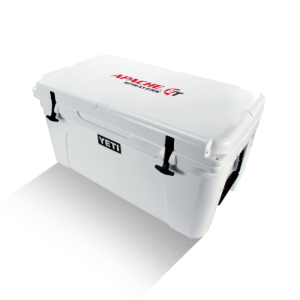
If tumblers and koozies aren’t enough, you can go bigger and better with a fully customizable cooler. High-end coolers are the way to go when you want to “treat” your key customers with something big or if you want to make a giveaway standout.
This year, Apache Sprayers gave away 100 of these YETI coolers with the purchase of a self-propelled sprayer — they SOLD OUT in record time.
Pop Some Bottles
Companies are allowed to have a little fun every once in a while, right? Show your appreciation with some custom bar accessories to make your brand the life of the party: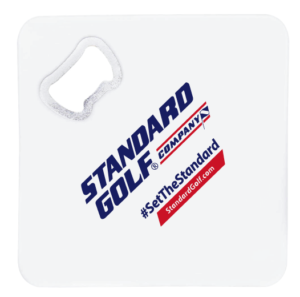
- Wine Bottle Tote – Take the fun with you to the next company outing, but make sure its full!
- Bottle Opener & Coaster – As part of a trade show promotion, Standard Golf left these customized coasters around gathering areas and social hours to promote their booth. They were swiped up quickly by show attendees.
T-Shirts Never Fail
We’re big fans of the tried-and-true custom T-shirt at LF. Stop by our office on any given day and you’ll see nearly half the office decked out in LF gear. We can testify that apparel companies have figured out that comfort and fit are just as important as the logo on the shirt. We go for T-shirts with super soft, rayon fabric in various styles depending on the look we’re going for. We love our tee’s and thus we love promoting ourselves as walking billboards around town — you can do the same for your brand!
Not sure where to start with your 2018 swag goals? We got you covered. Reach out to the team with the best swag insight in Des Moines!
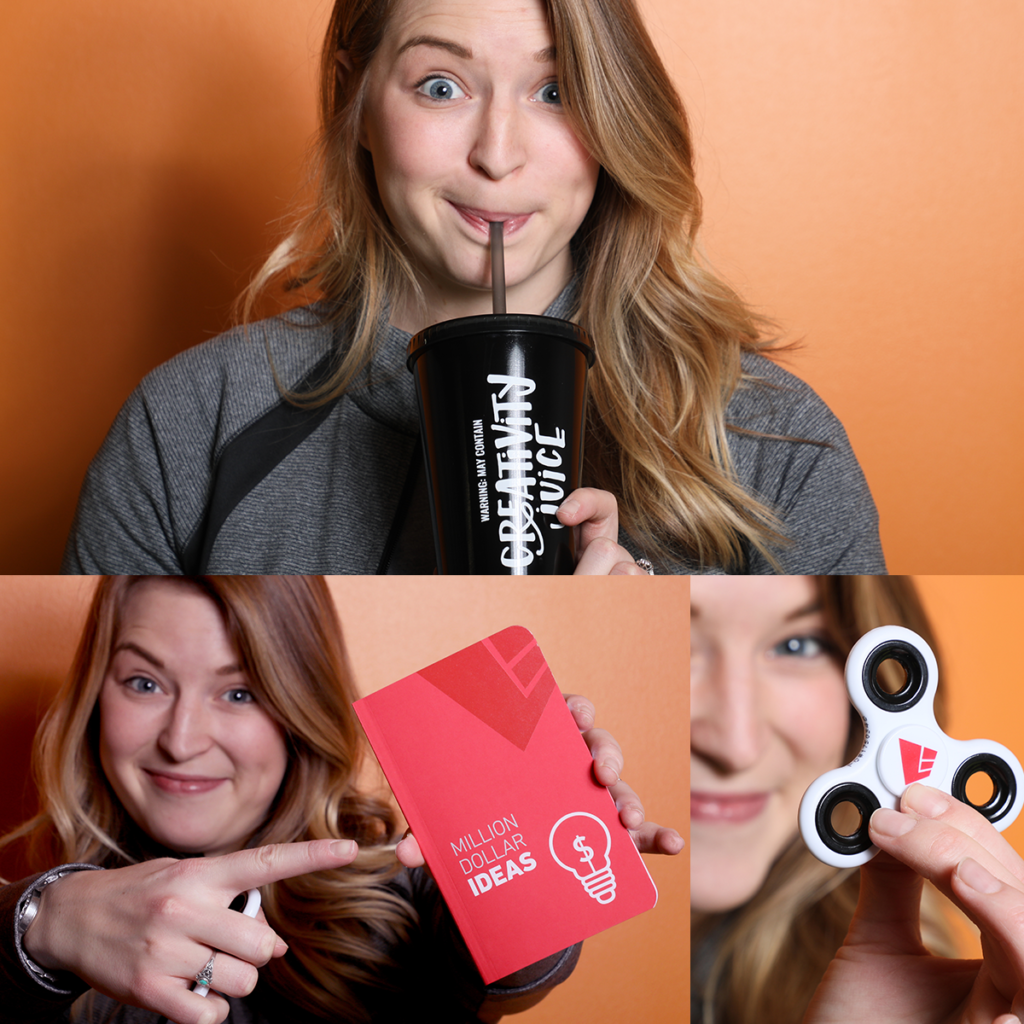
In 1993, Gary Sage set out to create a system for a better oil change. His idea was simple: create a machine that would eliminate oil spills on the ground or on himself. After some initial trial and error, the Sage Oil Vac system was born. Sage quickly realized that his invention would not only be cleaner for the average jobsite but environment as well. Not to mention it cut oil change times in half. Today, the ever-expanding Sage Oil Vac on-site fluid handling and maintenance products have made their way into a number of industries including oil and gas field service, heavy equipment fleet operators, generator maintenance, rental fleet companies and more.
The Problem
Knowing the history of Gary’s initial goal when he created the Sage system, it was well-established that one of the biggest jobsite pain points was the mess that comes from changing oil. Our challenge was straightforward — how can we promote one of the most sought-after benefits of Sage Oil Vac equipment: its cleanliness. We know Sage equipment reduces oil changing hassles, mess, expense and time — but getting customers to understand the main benefit (LESS MESS) and eliminate their pain point was our first priority.
We drew inspiration from Sage’s attendance at CONEXPO where customers continually shared how they needed a system to make changing oil faster, easier and of course… cleaner. Competitor research executed via trade publications relative to the Sage Oil Vac consumer audience showed us that their competitors were doing just what we expected — ads with boring equipment photos including lists of features and benefits. While that’s all fine and dandy… is this strategy really going to grab anyone’s attention in all the advertising noise? Probably not. It was time to go to the drawing board.
The Solution
The following Lessing-Flynn brainstorm sessions were filled with crazy ideas — but then someone said, “Hey, what if we made a guy in a tuxedo use some Sage equipment?” That was when we all sat up. It was ironic, creative and different. That day, “The Cleanest Man on the Jobsite” concept was born.
Not only did this take a more relaxed and playful approach, than many of their rough-and-tough competitors, it actually spoke to the primary benefit — ending the work day as clean as you started. With the headline and theme determined, applying the creative look was either going to make or break the concept. We knew tossing a guy in a tux out onto a jobsite was nutty — but, with a well-executed photoshoot and the right applications, we knew we could carry this campaign home.
The Results
This campaign launched in June and has continued to bring in big successes with high engagement and reach. You can find the “Cleanest Man” creative on Sage Oil Vac’s social media channels, in their paid media strategy, company swag and we even incorporated it into their ICUEE tradeshow booth. The campaign’s video “So Fresh, So Clean” also won a 2019 Gold Addy Award from the American Advertising Federation. We’re so excited to see so many opportunities for this campaign and as it continues to grow legs in other avenues, Lessing-Flynn will be ready to execute each tactic with the same quirky creativity from initial brainstorm.
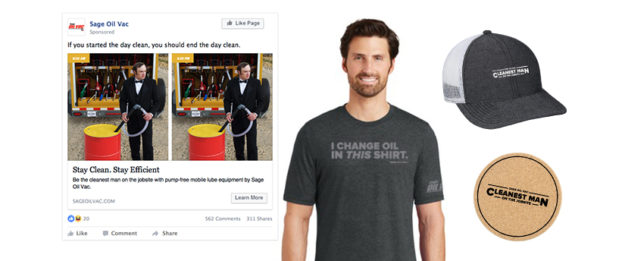
Our clients often come to us to help them plan and create memorable promotional items (or swag as we like to call it) for their business. These items are important for many reasons — they’re much more than just freebies at a trade show, each promo item is an opportunity.
An opportunity to make a new customer connection.
An opportunity to build brand recognition.
An opportunity to show your appreciation.
An opportunity to be seen.
So, without further ado we’ve gathered our top picks for branded swag in 2017:
Tumblers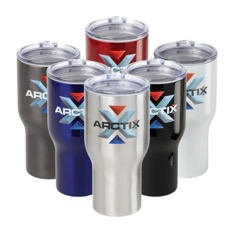
YETI® products were all the rage last year, and copper-lined tumblers have continued to be a trending item that anyone can appreciate. Vacuum-insulated mugs keep liquids hot for a remarkable amount of time (keeping ice frozen for up to 48 hours!). Promotional vendors have certainly stepped up their game with additional shapes and sizing options to allow clients to customize colors and logo imprints on the outside for better personalization.
Work Lights/Flashlights
Many clients in the agriculture and construction industry aim to provide products that are useful instead of a lower budget “throwaway item.” You have put yourself in your customers’ shoes and think about their daily habits. What would a pig farmer or corn grower want in their truck? Higher-end flashlights are multi-functional, durable and can be extremely useful. Now you can fill their days with light (subliminal messaging? totally).
Hitch Covers
Forget bumper stickers — heavy-duty hitch covers are the new, upgraded way to show off brand loyalty. You can never go wrong with a swag item that will be seen by many — these babies are like traveling billboards.
Phone Thong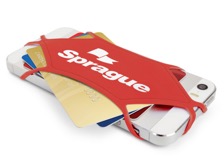
Yes, you can give out thongs and keep your brand rated PG. These newfangled phone thongs hold credit and debit cards on your phone, but they look like… you know. Super practical and a fun conversation starter piece for whoever wants to show off your brand! These were a big hit at a recent trade show for National Pork Board.
Power Chargers
Low battery? That’s the worst. Be the hero with a branded power bank charger — they’re crazy customizable! Many companies now offer full-imprinting in four-color formats, in addition to custom molds so you can create just about any object. I don’t know about you, but I’d love an Iowa Corn power bank with me at all times.
Socks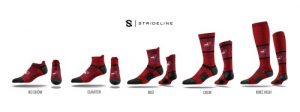
Want to put your best foot forward (ha! sock joke.)? Customized socks are the way to go. During the cold winter months, your brand can live on your favorite customers’ feet! We love Strideline’s sock line — they can be fully-personalized with your logo and brand colors. Shoot, we might even get some for our office. #FlynnieFeet
Express Yo’self or Your Brand
We’re encouraging all brands to think outside the box with swag this year. It can make all the difference in the world, especially when your customers start actually using the items you give them. Mix it up and be creative — the options are endless! Need help with your 2017 swag strategy? We’ve got your back! Contact Lessing-Flynn today.